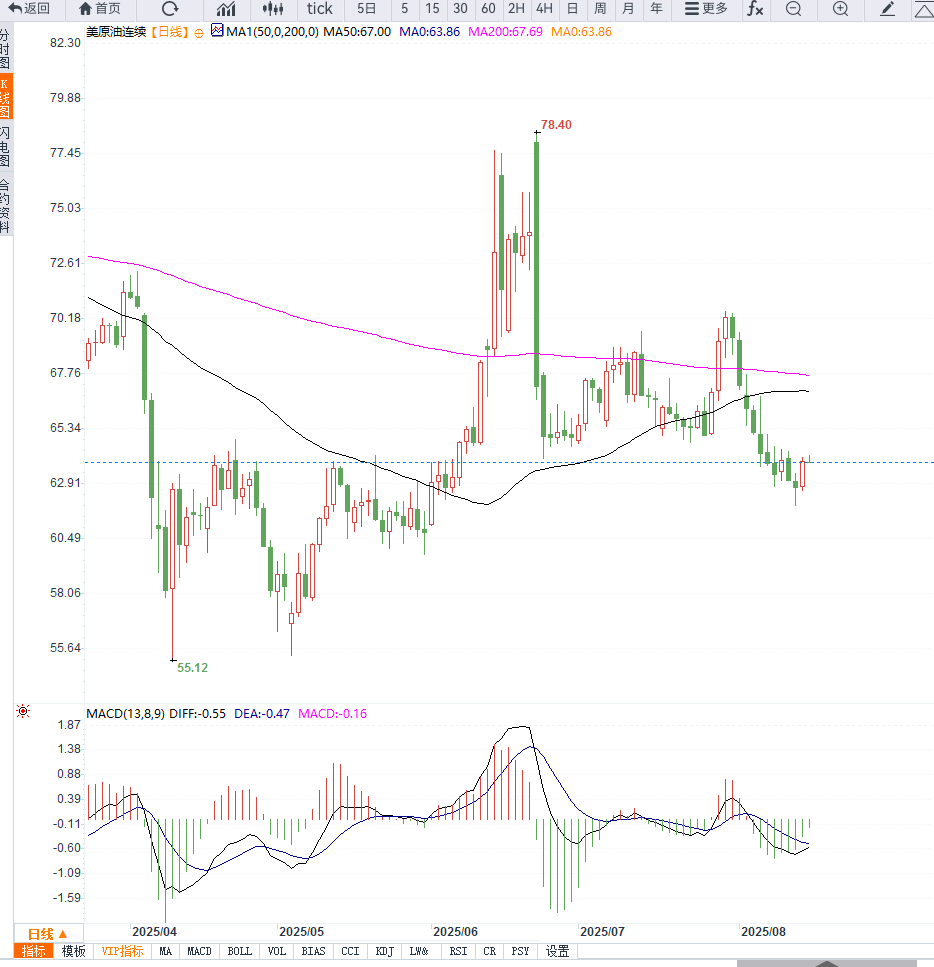Crude oil trading reminder: Geopolitical uncertainty drives oil price rebound, but does not change the medium-term downward trend
2025-08-15 09:25:00
Brent crude futures rose 0.2% to $67.00 a barrel, while U.S. West Texas Intermediate (WTI) crude futures also rose 0.2% to $64.10 a barrel.
The primary factor driving the market was geopolitical risk, with U.S. President Trump warning of "consequences" if Russia obstructed the Ukraine peace deal, a comment that heightened market concerns about tight crude oil supplies.

The market is focused on the meeting between Trump and Russian President Vladimir Putin in Alaska that day, with the Russia-Ukraine ceasefire being a core issue. The ongoing conflict is believed to be likely to limit Russian oil supplies, thus supporting oil prices.
Market analysts pointed out that the uncertainty of the situation between Russia and Ukraine has kept the crude oil market's concerns about supply disruptions high, which has supported oil prices in the short term.
Meanwhile, Japan's latest economic data showed that its second-quarter performance exceeded market expectations. Government data released on Friday showed that GDP grew 1.0% annualized in the second quarter, significantly higher than the market expectation of 0.4%. The quarter-on-quarter growth was 0.3%, also higher than the expected 0.1%.
As one of the world's major crude oil importers, Japan's steady economic expansion is expected to increase its crude oil demand.
An energy economist said that Japan's economic recovery may further boost oil consumption demand in the Asian market in the second half of the year.
However, oil price gains remain constrained by the outlook for U.S. interest rates. Recent higher-than-expected U.S. inflation data, coupled with weak employment data, have fueled concerns that the Federal Reserve may maintain high interest rates for longer. Higher interest rates typically dampen economic activity, thereby reducing energy consumption.
Energy market consultants believe that expectations of higher U.S. interest rates could put upward pressure on oil prices in the coming months.
Looking at the daily chart of US crude oil, prices have broken through the upper edge of the short-term consolidation range and stabilized above the 20-day moving average, strengthening short-term bullish momentum. The MACD indicator's fast line crossed upward through the slow line to form a golden cross, indicating a high probability of a continuation of the upward trend.
The RSI indicator is close to 60, indicating further upside potential. If the price can successfully break through the $64.50 resistance level, the next target is expected to challenge $65.30; the lower support level is $63.20, and if it falls below, it may retest the $62.50 area.

Editor's opinion:
Judging from the current market structure, geopolitical risks and positive economic data have jointly driven oil prices upward, but the shadow of high US interest rates remains a significant concern. In the short term, oil prices are likely to remain high and volatile, with their specific direction depending on the development of the Russia-Ukraine situation and changes in macroeconomic data from major economies.
The technical side shows that bulls have the upper hand in the short term, but we need to pay attention to the effectiveness of breaking through the key resistance level above.
- Risk Warning and Disclaimer
- The market involves risk, and trading may not be suitable for all investors. This article is for reference only and does not constitute personal investment advice, nor does it take into account certain users’ specific investment objectives, financial situation, or other needs. Any investment decisions made based on this information are at your own risk.





















